Highly passive material is presented in the field of construction. More precisely, it will be said ...
|
|
One of the most popular floor coverings laminate. It is used in residential and ... |
When asked which house is the most durable, the answer is obvious monolithic. And if earlier ... |
How to quickly level the floor in the apartment with your own hands. Features of the installation of dry screed with expanded clay
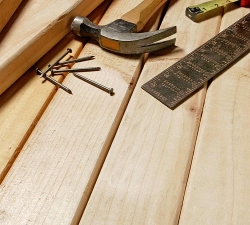
When the overhaul of the dwelling is planned, you can not do without leveling the floor. Most often, the floor has bumps, the wrong angle of inclination, which can affect the quality of the laying of the flooring. Also, an uneven floor can cause problems with the location of furniture in level, installation of doors or when gluing wallpaper. Experienced craftsmen know that high -quality overhaul begins with the floor, and ignoring this issue will make every effort to nothing. The floor screed in the apartment is a very important issue in the process of overhaul. There are various options for leveling the floor, each of which has its own positive and negative sides.
Table of contents:
- Ways to align the floor
- Preparation of the flooring for leveling
- Dry floor screed in a dwelling
- Advantages of dry floor screed
- Dry screed technology
- Instructions for installing a dry screed with expanded clay
- Comparative characteristic of dry and cement screeds
- Disadvantages of dry screed
Ways to align the floor
Among various options for aligning the floor, the most common are the following:
- use of a leveling solution;
- screed with concrete or sand cement screed;
- leveling of the surface by using expanded clay;
- legal alignment by lags.
But various options are combined into three ways:
- sandy cement screed;
- dry screed;
- the screed by self -leveling mixtures.
Each of these methods has positive and negative aspects and can be used in one case or another, depending on the degree of floor irregularities.

Preparation of the flooring for leveling
The floor for leveling must be specially prepared. There is an algorithm of actions, the performance of which will give an excellent result:
- Preparation of the surface in order to prepare the surface, it is necessary to remove the old coating, under the layer of which cracks, irregularities formed, garbage, dust can be collected. The protrusions and tubercles are cleaned with a perforator, cleaned, achieving a perfectly flat floor. All garbage is collected so that the installation of a new coating does not interfere and does not distort the surface of a new canvas.
- The waterproofing of the surface as can be seen from the name of the action, this is the isolation of the surface from the leakage of the water. In rooms with high humidity or threat of water leaks, a semblance of a waterproof basin is created, it is in this niche that is filled with a screed. Rooms that do not require additional protection against leakage are simply processed at the joints of the material, boundaries with side surfaces and under pipes. Some masters note that the coating of the entire surface of the floor will not hurt the future screed at all.
- Laying a shock absorber around the perimeter of the room a damper film helps with temperature changes as a monolithic screed, and will become protection from extraneous sounds when touching the slabs on the side coatings.
- Finding a zero level on the surface of the floor, it is necessary to find the highest point and adding the thickness of the screed to it, mark the point of the control line on the wall. It is necessary to check the correctness of the laid line using the level. It should also be taken into account whether the chosen height will affect the opening of the doors, whether there is no need to raise the batteries. These important issues cannot be missed so as not to be in a difficult situation after the end of work.
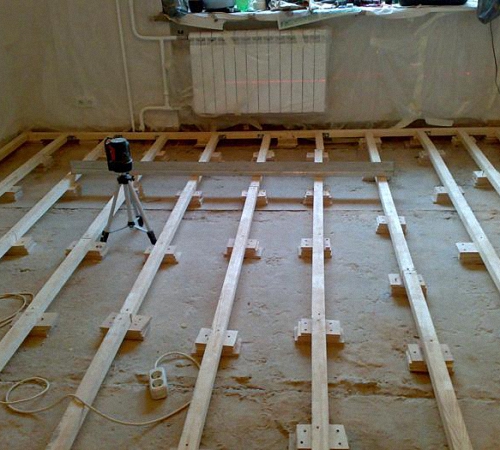
Dry floor screed in a dwelling
In order for the coating in an apartment or at home for a long time, it is necessary to responsibly approach the issue of screeding the floor. Currently, a dry screed is considered the simplest, fast and economically profitable. But like each method, this method has its advantages of AI disadvantages. The successful result depends on the correctly carried out procedure, and for this it is necessary to study in detail and in detail the technology of the dry screed.
This method is available to domestic craftsmen, that is, it is a relatively easy option. The screed procedure itself is divided into stages:
- waterproofing;
- backfill with expanded clay;
- laying sheets of strong material.
You can perform such a screed on two types of surface:
- on concrete;
- on the lags.

To perform a dry screed yourself, you need to prepare the necessary materials:
- waterproofing film;
- metal profiles for fixing lighthouses;
- dampfer tape;
- expanded clay;
- sheets from chipboard, plywood, gypsum fiber;
- glue;
- self -tapping screws;
- screws;
- level;
- pencils, long ruler.

Advantages of dry floor screed
This technology has several advantages. Among the main advantages of the method, one can distinguish the following:
- with this technology, there is no dirt, since the method eliminates the use of water;
- a lot of time savings, there is no need to wait, the surface is available for use immediately;
- the ability to make a screed not only in the seasonings convenient for repair, but year -round;
- the technology is especially valuable for use in dilapidated or old buildings as it has relatively lightweight;
- it has good insulating abilities- water, sound and thermal insulation;
- the economical method does not need to hire repair teams, you can make a screed yourself, even without involving assistants;
- the minimum cost of energy can be made quickly and without special energy consumption;
- the final result can be adjusted and improved;
- there are no restrictions for installing communications.
For a dry method, expanded clay is most often used. This substance helps to align unevenness, to fill the recesses.
Technology is used for a very uneven surface of the floor. The use of a concrete screed in this case is problematic, in addition, it will have a very large weight and this can create an overload for floor slabs. And uneven drying due to different levels of solution will lead to the formation of cracks.
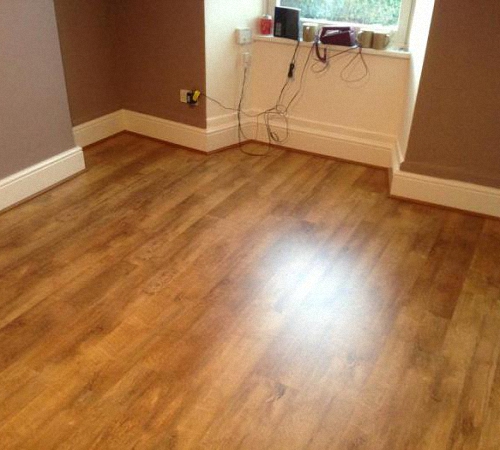
Dry screed technology
Before starting work, you should study the theoretical issues in detail and stock up on the necessary materials and tools. In order not to spend money on extra materials or not to look for any missing, you should correctly calculate the size and amount of the necessary material. For the correct calculations, it is necessary to perform simple arithmetic actions- to divide the area of \u200b\u200bthe room into the area of \u200b\u200bthe sheet as a result will be known the number of necessary sheets. When buying a film, you need to buy an additional meter, since you will have to lay it with a margin, applying the edges on each other and leaving a place for bending along the wall. The remaining materials are calculated taking into account the thickness of the screed.
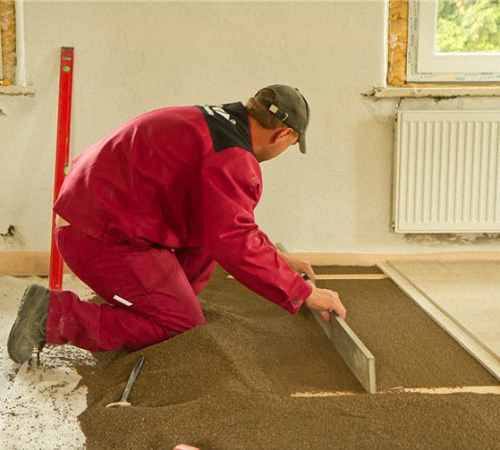
Before the work, it is necessary to prepare the surface of the floor. The old coating is removed and the floor is freed to the concrete slab. The surface defects are eliminated by cementing with a special solution. After complete drying, the surface is freed from pollution.
Material for waterproofing is laid on the purified surface. It should be controlled so that the material closes the floor completely and also the surface of the walls around the entire perimeter of the dwelling. The place left on the wall corresponds to the level at which expanded clay or similar material will be poured. The edges of the film are attached with special construction tape. This guarantees protection against wet air through the floor slabs from the lower floors or basements.
Then a damper ribbon is attached to the film, it is glued without effort. It is simply necessary to remove the protective coating and glue on the film. It prevents the contact of the screed with the walls. Also, a feature of the tape is the protection against the creak.

Instructions for installing a dry screed with expanded clay
After preparatory work and the installation of waterproofing, they proceed to the installation of lighthouses. For this, several screws and a laser level are used. Using the level, the correct horizontal lines are noted. The beacons are fixed on both sides with a gypsum or cement mortar.
The next step is to backfill - it can be granotsev, expanded clay or a special substance for filling. Most often, the choice stops at expanded clay. In this case, it is necessary to choose a finely defined expanded clay. Large granules can make it difficult to set the floor level. They fall asleep expanded clay in parts, it is more convenient to distribute the mixture and control the correctness of the layer thickness. It is recommended to make it at least thirty centimeters. Equate the height of the backfill according to the beacons established earlier.
The surface after laying the dry mixture is covered with sheets of durable material. It can be gypsum fiber sheets, chipboard or plywood. Thin sheets are laid on each other and fastened with glue and screws. If the material has a thickness of more than one and a half centimeters, you can lay it in one layer. The surface of such material is ultimately covered with protective solutions, such as mastic or olifa. It is necessary to lay the sheets so that there are at least gaps between them. If the sheets do not contact each other tightly enough, the gaps should be covered between the seams with putty.
It is necessary to take into account such a moment that with partial backfill, the process begins from the farthest corner from the entrance, and if the backfill is complete, then from the front door.
When the sheets are laid, it is necessary to cut off the film that is visible around the perimeter of the room.
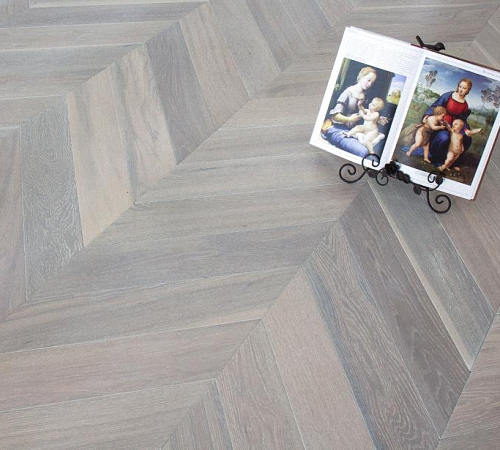
Comparative characteristic of dry and cement screeds
Each of these methods has its own advantages, but if you compare the dry and concrete screed, you can distinguish a number of points indicating the priority of the dry method.
Features of dry screed:
- does not require a drying of the surface;
- has a high manufacturing speed;
- does not depend on weather conditions and temperature conditions;
- due to expanded clay, heat retention is carried out;
- high sound insulation.
Features of cement screed:
- a long period of drying, more than a month;
- long manufacture time, more than a week;
- requires the warm season, depends directly on the temperature regime;
- low ability to retain heat;
- low noise insulation.
With all the fact that the dry method has a large number of advantages, the method is not as easy as it might seem. The team of experienced workers will make a dry screed per day, but if you plan to independently perform work, you should be patient and be careful. It is possible that it is unrealistic to carry out a screed in a day, but the result of the work, carried out independently, will be doubly pleasant, and he will also save money.
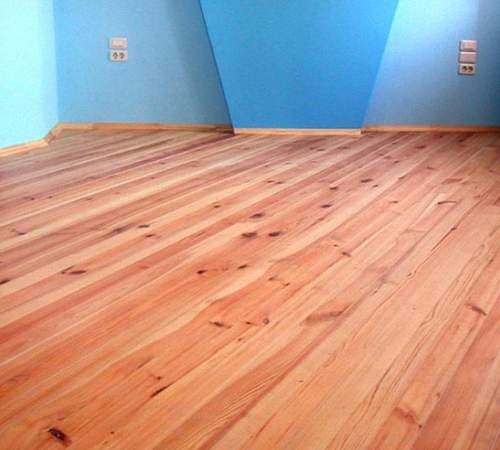
Disadvantages of dry screed
As you can see, there are a lot of advantages of dry screed and another, no less important advantage of technology, low cost compared to others.
But one serious drawback is the moisture of expanded clay screed.
The film will reliably protect against leaks and moisture, since water or moisture is detrimental to a dry mixture. Contact with moisture can cause a swelling of the substance and, as a result, deformation of the finish coating, linoleum, laminate. To avoid this scenario, the surface is covered with specially designed protective substances.
But if you carefully protect the dry mixture from possible contact with moisture, this technology is considered reliable and optimal when carrying out the maintenance of the floor.

This is one of the most important disadvantages of the method. Among the negative aspects of using this technology, the following points can be distinguished:
- this screed option is extremely sensitive to moisture and when using dry mixtures for aligning the floor, waterproofing is given much attention;
- this method of leveling the floor is not recommended in a room with a large number of visitors;
- often an extraneous sound appears when moving around the room, this deficiency will disappear over time;
- in residential premises, the use of this technology is not desirable in the bathroom, kitchen;
- the appearance of rodents is possible, since this layer is a comfortable habitat for mice and insects.
If you still have questions about how to align the floor at home using a dry screed, watch a video that tells in detail about the technology and basic requirements for the process.
